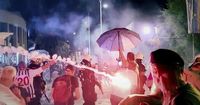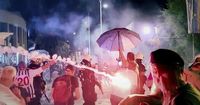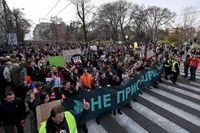Serbia was plunged into turmoil this week, as violent clashes between government supporters and opposition demonstrators erupted across the country, leaving dozens injured and exposing deep divisions over the future of President Aleksandar Vučić’s populist administration. The unrest, which has been brewing for months, reached a breaking point on August 14, 2025, when protests in major cities such as Belgrade and Novi Sad descended into chaos, with riot police battling to restore order amid allegations of corruption, foreign interference, and a contested election.
The first sparks of violence ignited on August 13 in the northwestern town of Vrbas, according to AP and reports cited by News18. There, rival groups gathered outside the offices of Vučić’s ruling Serbian Progressive Party (SNS), forcing riot police to intervene. Police Commissioner Dragan Vasiljević told state broadcaster RTS that protesters "came to attack" the president’s supporters, setting the tone for what would become a nationwide escalation by the following day.
By August 14, the unrest had swept through the capital, Belgrade, as well as Novi Sad, Kragujevac, Čačak, and Niš. According to AFP and News18, SNS supporters hurled firecrackers and flares at anti-government demonstrators, who responded with vandalism, including smashing windows at SNS offices in Novi Sad. The violence left at least 16 police officers and about 60 SNS supporters injured, with several arrests reported by authorities. Riot police deployed tear gas to disperse crowds in Belgrade, while similar scenes unfolded in other cities as frustration boiled over.
Interior Minister Ivica Dačić, quoted by multiple outlets, confirmed the injury toll and suggested that "the violence may have been influenced by foreign powers," a claim that added fuel to an already volatile situation. Dačić called for a "firm response" and the "return of law and order," echoing official concerns about the scale and intensity of the protests. The government, for its part, has consistently blamed the opposition and protesters for inciting violence, with President Vučić himself describing them as "thugs and terrorists" in public remarks.
But for many Serbians, the roots of the unrest run far deeper than a single night of chaos. The demonstrations form part of a months-long movement against Vučić’s administration, which has faced persistent accusations of corruption, cronyism, and the erosion of democratic standards. According to News18 and AFP, the protests began in earnest in November 2024, following a tragedy that shocked the nation: the collapse of the Novi Sad railway station roof, a Chinese-funded project, which killed 16 people. The disaster was widely blamed on government corruption and shoddy construction, galvanizing public anger and uniting a broad coalition of opposition groups, student organizations, and civil society activists.
The December 2024 parliamentary and local elections further inflamed tensions. As reported by AFP, prominent figures from Serbia’s intellectual, artistic, and celebrity communities joined the outcry, alleging widespread electoral fraud and challenging the legitimacy of the results, which delivered a substantial victory to the SNS and President Vučić. The opposition, led by the group 13 August, has refused to accept the outcome, demanding early elections and an end to what they describe as Vučić’s 13-year rule.
In the words of protesters at a December rally organized by the pro-democracy movement ProGlas, "We don't accept!"—a slogan that has become a rallying cry for those who see the current government as illegitimate and unaccountable. Demonstrators have called for greater transparency, accountability, and a return to democratic norms, citing not only the recent election but also a broader pattern of media suppression, executive overreach, and disregard for the rule of law.
The government, however, has pushed back forcefully against these accusations. President Vučić and his allies insist that the protests are orchestrated by political opponents seeking to destabilize the country, and have pointed to alleged foreign interference as evidence of a broader conspiracy. Interior Minister Dačić’s comments about outside influence have been echoed by other officials, even as critics argue that such claims are designed to distract from the administration’s own failings.
Serbia’s international relationships have also come under scrutiny amid the crisis. While the country remains a candidate for European Union membership, Vučić’s government has maintained strong diplomatic and economic ties with both Russia and China. These relationships have drawn criticism from EU officials and domestic reformers alike, who argue that Serbia’s future lies with the West and warn that continued authoritarianism could jeopardize its accession prospects.
For ordinary Serbians, the stakes could hardly be higher. The collapse of the Novi Sad train station, widely seen as a symbol of government negligence, continues to haunt the national psyche. Protesters have pointed to the tragedy as proof of what they describe as endemic corruption and a lack of oversight in state projects, particularly those involving foreign investment. The resulting anger has brought together diverse segments of society, from students and intellectuals to workers and urban professionals, all united by a sense of betrayal and a desire for change.
Meanwhile, the government’s response has only hardened opposition resolve. The use of riot police, tear gas, and mass arrests has drawn condemnation from human rights groups and international observers, who warn that Serbia risks sliding further into authoritarianism if the underlying grievances are not addressed. Yet, for now, neither side appears willing to back down. The SNS and its supporters continue to mobilize in defense of Vučić, while the opposition has vowed to keep up the pressure until their demands for early elections and accountability are met.
As the dust settles on another night of violence, Serbia finds itself at a crossroads. The country’s path forward remains uncertain, with both government and opposition locked in a high-stakes struggle for the nation’s future. Whether the current crisis will lead to meaningful reform or further entrench division is anyone’s guess. But one thing is clear: the voices raised in protest are not likely to be silenced anytime soon.
For now, Serbians on both sides of the divide are left to grapple with the aftermath of clashes that have laid bare the country’s political fault lines—and to wonder what comes next.



